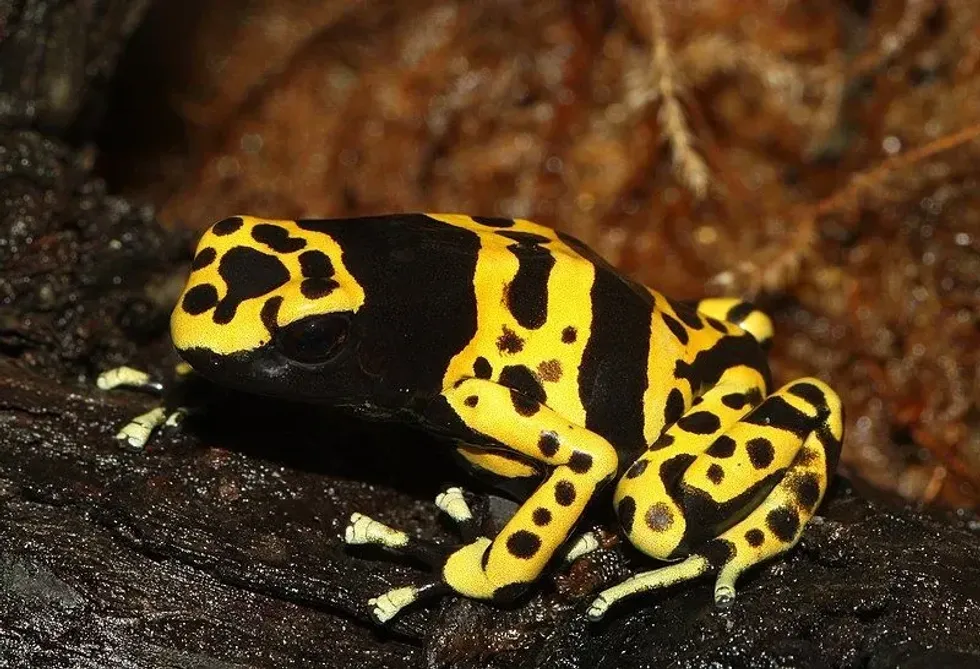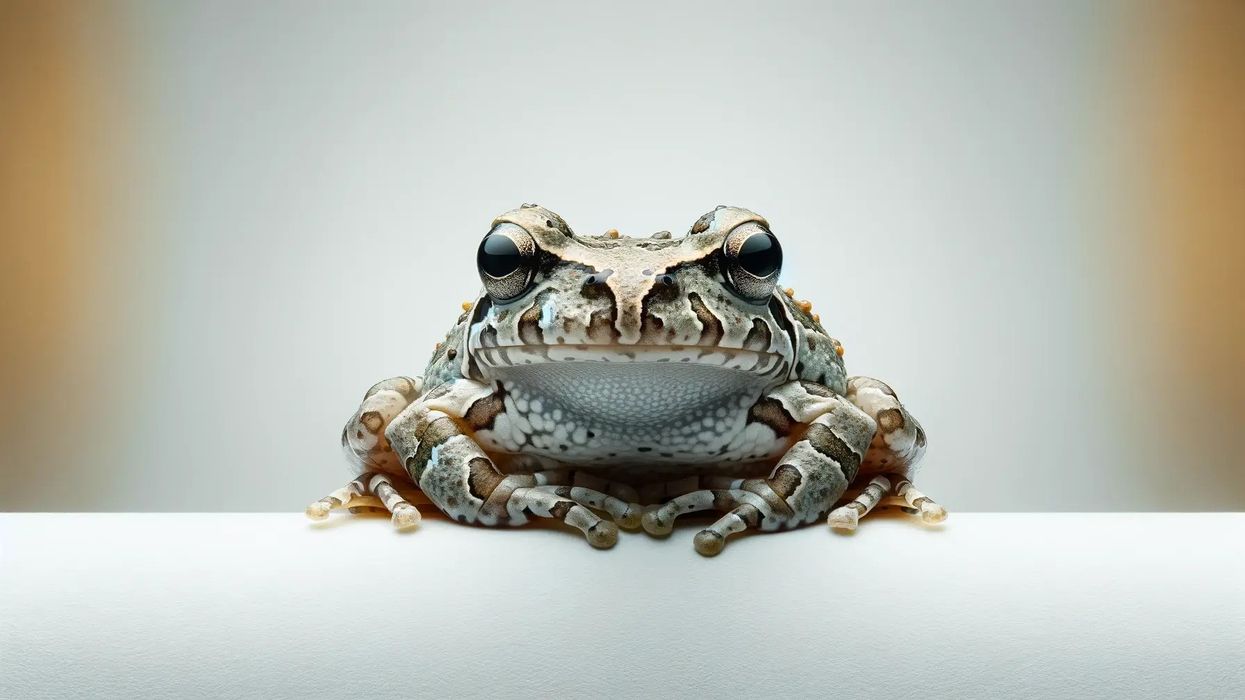The poison dart frog (Dendrobates leucomelas) is one of the most dangerous species of frogs. One of them is the yellow-banded poison dart frog!
The name of this frog is as such because back in old times, the native Americans would rely on poison dart frogs to acquire the toxins which would be used to poison the tips of blowdarts. This amphibian has a beautiful appearance that stands out as compared to others.
It has black and yellow stripes all over its body. Due to its strong resemblance to bumblebees, they are also referred to as bumblebee poison dart frogs!
If you observe closely, you will see that each (Dendrobates leucomelas) have their own unique pattern over their body. However, you must keep in mind that although this creature is small in size, it is just as deadly, especially in the wild.
Dendrobates leucomelas have striking colors on their body to ward of their potential predators or anything they are threatened by. This species main weapon is its toxin. It secretes toxins from its skin, which is obtained by eating ants.
Just their appearance causes a lot of animals to steer away from this beautiful frog. The poison transmitting through poison dart frogs, dendrobates, vary within the species. Some of the toxins have high potency which can cause fibrillation and heart failure.
If you like reading animal facts, be sure to check out Chinese giant salamander facts, or Japanese giant salamander facts.
Yellow-banded Poison Dart Frog Interesting Facts
What type of animal is a yellow-banded poison dart frog?
The poison dart frog, Dendrobates leucomelas, is a yellow-black amphibian found under logs, damp forests, wet soil. These frogs are of the largest species belonging to the genus Dendrobates. they are territorial when it comes to their natural habitat.
Even though they are relatively small, they are aggressive. Male frogs tend to be more aggressive compared to female frogs. These frogs are diurnal, meaning that, unlike other frogs which are very active at night, these are active during the day.
What class of animal does a yellow-banded poison dart frog belong to?
Yellow-banded dart frog (Dendrobates leucomelas) belong to the amphibia class and come from the family of Dendrobatidae. This family comes from tropical central and south America.
How many yellow-banded poison dart frogs are there in the world?
As the exact number of this species is unknown, there is no information available.
Where does a yellow-banded poison dart frog live?
Poison dart frogs are often found in neotropical areas and evergreen forests. The yellow-banded poison dart frog range includes the northern part of South America, specifically Venezuela. This species is distributed throughout this range.
What is a yellow-banded poison dart frog's habitat?
The yellow-banded poison dart frog habitat consists of areas that are damp, wet, and have a humid temperature. You can spot them in forests near lakes, often hidden away in heaps of foliage, they enjoy being close to lakes and rivers.
Who do yellow-banded poison dart frogs live with?
Poison dart frogs are solitary except when they are breeding. Other species of frogs are ignored and avoided. Tadpoles live in the water and cause a vibration to alert other adult frogs of their presence. However, the adult yellow-banded dart frog (Dendrobates leucomelas) prefers to be in solitude.
How long does a yellow-banded poison dart frog live?
The yellow-banded poison dart frog life depends on whether they are under captivity or in the forest. The species life expectancy is higher when they are taken care of at home, they live for 10-15 years. In the case of those frogs that live in their natural habitat, their life span decreases to five to seven years.
How do they reproduce?
These frogs mate in between the months of February and March. To initiate courtship, the male frog attracts the female frog by giving out mating calls.
Did you know that they have the loudest mating calls! They also show off their vibrant colorful bodies in order to attract female frogs. After the female selects the male frog, the male directs her to his chosen breeding spot, where the female lays eggs.
These fertilized eggs are taken care of by the male frog and when they hatch into tadpoles, the male frog carries them to water-holding plants (such as bromeliads) in order to develop. Tadpoles form vibrations in the water to inform of their presence to other males carrying tadpoles so that they don't place their tadpoles in an occupied plant.
However these babies are not safe on their own, giant damselfly nymphs prey on tadpoles.
What is their conservation status?
Its conservation status falls in the category of Least Concern indicating that the yellow-banded poison dart frog distribution is stable! They are quite adaptable when it comes to their habitat. It can adjust well to areas that have lower temperatures.
Yellow-Banded Poison Dart Frog Fun Facts
What do yellow-banded poison dart frogs look like?
Defined by its striking yellow and black bands. Each frog has its own unique pattern, as they grow older their black bands start breaking into spots. They look magnificent! They have a robust body and are the largest frogs in the Dendrobatidae family, this is one of the reasons their conservation status is at Least Concern!
How cute are they?
These frogs are beyond cute! They are fascinating. Their patterns are mesmerizing to the viewer and make them stand out in nature! But don't take their appearance for granted. These frogs are not to be messed with! It's better to not bother them as they can strike back!
How do they communicate?
The bumblebee frog from South America is very vocal when it comes to its territory and while breeding. They begin communicating as tiny tadpoles. The adult frog is very expressive, when its territory is at stake, it emits a loud call and engages in belly-to-belly grasping, chasing too! They often attack their neighboring frogs.
How big is a yellow-banded poison dart frog?
The yellow-banded poison dart frog size ranges from 1.8-1.9 in (4.5- 4.8 cm) which makes them the largest of their species. However, it still happens to be ten times smaller than the Goliath frog!
How fast can a yellow-banded poison dart frog move?
This species is known to run about 10 mph (16 kph). Their toes and fingertips have glandular adhesive pads which help them climb and cling to plant surfaces so they can move around easily.
How much does a yellow-banded poison dart frog weigh?
The yellow-banded poison dart frog diet influences their weight. Often females tend to be larger and robust in size as compared to males. Their average weight is 0.11 oz (3 g). Although they are small in size they are ferocious in their habitat.
What are the male and female names of the species?
There are no specific names assigned to each sex. They share the same scientific name.
What would you call a baby yellow-banded poison dart frog?
Frog off-springs are called tadpoles, froglets, and polliwogs.
What do they eat?
As they are insectivores they feed on ants, termites, water beetles, crickets. When in captivity, fruit flies and other small insects can be used to feed them.
They lose their toxins when they are captivated. This is because they are no longer deriving toxins through ants and other insects as their diet is restricted. Tiny tadpoles tend to feed on other new tadpoles placed in the same water plant as them.
Are they poisonous?
Yes, they have poisonous toxins on their skin. In the wild, they are harmful if you bother them. Their toxins have been proven to kill humans and cause heart attacks. In human care, they are not harmful. It is also seen that these frogs produce enough poison to kill a human in less than ten minutes!
Would they make a good pet?
Yes, they are harmless when confined. They make great pets as their diet consists of pesky insects which you can feed them! They breed easily under captivity.
Did you know...
To attract females, these frogs give out bird-like trills for ten to fifteen seconds. Mating calls include chirps, hums too!
The poison frog can live twice its lifespan in captivity as compared to living in the wild.
Different types of poison dart frog
There are many variations of this species, such as golden poison frog, strawberry poison dart frog. They all vary in size and have bright-colored bodies. They have different life spans and diets. Some are carnivores, others are insectivores.
Can you die from touching a poison dart frog?
Yes, especially the golden poison frog, it is deadly and can kill a human in ten minutes! The most potent toxins come from this frog.
Here at Kidadl, we have carefully created lots of interesting family-friendly animal facts for everyone to discover! For more relatable content, check out these olm facts and bullfrog facts pages.
Kids can have a fun time at home by coloring in one of our free printable yellow-banded poison dart frog coloring pages.










